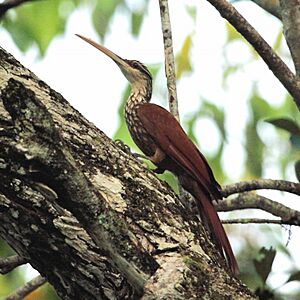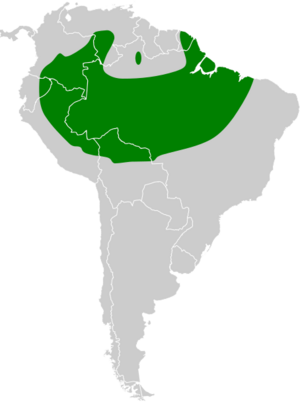Long-billed woodcreeper facts for kids
Quick facts for kids Long-billed woodcreeper |
|
|---|---|
 |
|
| at Apiacás, Mato Grosso state, Brazil | |
| Conservation status | |
| Scientific classification | |
| Genus: |
Nasica
|
| Species: |
longirostris
|
 |
|
The long-billed woodcreeper (Nasica longirostris) is a fascinating bird found in the forests of South America. It's known for its incredibly long beak, which helps it find food. This bird is part of the ovenbird family called Furnariidae. You can spot it in countries like Brazil, Colombia, and Peru.
Contents
About This Bird's Family
The long-billed woodcreeper is special because it's the only bird in its group, called Nasica. Think of it like being the only one of its kind in a small family branch! Its closest relative is another bird called the cinnamon-throated woodcreeper.
Birds living south of the Amazon River often have much longer bills. Some experts even thought they might be a different type of long-billed woodcreeper.
What Does It Look Like?
The long-billed woodcreeper is one of the biggest woodcreepers around. It has a slim body and a small head. Its neck and tail are quite long. The most noticeable feature is its super long, slightly curved beak.
This bird is about 34 to 36 centimeters (13 to 14 inches) long. It weighs between 78 and 92 grams (2.7 to 3.2 ounces). Both male and female birds look very similar.
Its head and neck are dark brownish-black with light streaks. It has a white stripe above its eye. Its throat and the front of its neck are also white. The back, wings, and tail are a bright reddish-brown color. The tips of its outer wing feathers are dark brown.
Its chest and sides have black and white streaks. The rest of its belly is a yellowish-brown with spots and bars. Its eyes can be yellowish-brown, reddish-brown, or dark brown. The beak is usually ivory or light gray. Its legs and feet are gray or brown. Young birds have lighter colors and less clear streaks on their chest.
Where Does It Live?
You can find the long-billed woodcreeper across a huge area in South America. This includes the Orinoco River Basin in Venezuela. It also lives throughout the Amazon Basin. This stretches from eastern Colombia and Ecuador to Peru and Bolivia. It also covers a large part of Amazonian Brazil. You can even find it in French Guiana.
This bird usually lives near water. It prefers the inside and edges of forests that flood seasonally. It also likes forests along rivers and in swamps. You might also see it on well-wooded islands in rivers. Sometimes, it lives in other types of forests, but less often. It usually stays below 300 meters (980 feet) in elevation. In some areas, it can be found up to 500 meters (1,600 feet) high.
Behavior
Movement
The long-billed woodcreeper stays in the same area all year long. It does not migrate.
Feeding Habits
This bird usually looks for food by itself. Sometimes, you might see a pair together. They can also join groups of different bird species looking for food. It moves along tree trunks and large branches. It searches from the middle parts of the forest up to the very top. It also pokes around in leaf clusters, plants growing on trees, and cracks in bark.
Its diet isn't fully known. However, it seems to eat mostly insects and other small creatures with exoskeletons. It also eats small reptiles and amphibians. Sometimes, it will eat prey that is trying to escape from swarms of army ants.
Reproduction
We don't know a lot about when long-billed woodcreepers breed. It seems to happen at least from January to May. One nest was found inside a tree hole about 4 meters (13 feet) off the ground. Both parent birds were seen feeding their young. We don't know how many eggs they lay. We also don't know how long the eggs take to hatch or when the young birds leave the nest.
Vocalization
The long-billed woodcreeper sings during the day, but not very often. Its song is loud and can be heard far away. It sounds like three or four eerie, sad whistles. People describe it as "t w o o o o o ó o o" repeated. It can also sound like "loud melancholy-sounding, drawn-out calls 'wuuuueet'" repeated a few times. Its other calls include sounds like "chat-ak", "chat-at-at", and "chuckling notes".
Conservation Status
The IUCN (International Union for Conservation of Nature) says the long-billed woodcreeper is a species of "Least Concern." This means it's not currently in danger of extinction. It lives across a very large area. However, we don't know exactly how many there are. Experts believe its population might be getting smaller. No immediate big threats have been found.
It is generally uncommon to fairly common. But it is rare in some parts of its range, like Bolivia and French Guiana. This bird is thought to be very sensitive to changes in its habitat.


